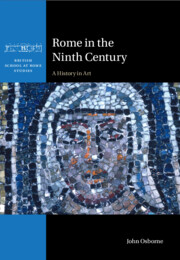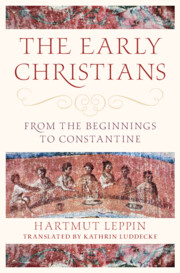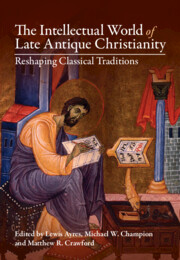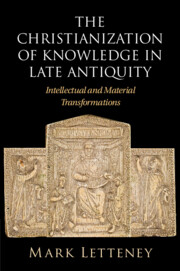Refine search
Actions for selected content:
23989 results in Ancient history
5 - New Bookforms
- from Part II - New Texts
-
- Book:
- The Christianization of Knowledge in Late Antiquity
- Published online:
- 28 September 2023
- Print publication:
- 12 October 2023, pp 127-144
-
- Chapter
-
- You have access
- Open access
- HTML
- Export citation
7 - The Roman Imperial and Late Antique Periods, c. 30 bc–c. ad 700
-
-
- Book:
- In the Footsteps of the Etruscans
- Published online:
- 12 October 2023
- Print publication:
- 12 October 2023, pp 214-245
-
- Chapter
- Export citation
Appendices
-
- Book:
- In the Footsteps of the Etruscans
- Published online:
- 12 October 2023
- Print publication:
- 12 October 2023, pp 296-349
-
- Chapter
- Export citation
Contents
-
- Book:
- Rome in the Ninth Century
- Published online:
- 10 October 2023
- Print publication:
- 12 October 2023, pp v-v
-
- Chapter
- Export citation
7 - Christian Tools in Traditionalist Texts
- from Part II - New Texts
-
- Book:
- The Christianization of Knowledge in Late Antiquity
- Published online:
- 28 September 2023
- Print publication:
- 12 October 2023, pp 172-198
-
- Chapter
-
- You have access
- Open access
- HTML
- Export citation
Abbreviations
-
- Book:
- The Christianization of Knowledge in Late Antiquity
- Published online:
- 28 September 2023
- Print publication:
- 12 October 2023, pp xv-xvi
-
- Chapter
-
- You have access
- Open access
- HTML
- Export citation
Preface and Acknowledgements
-
- Book:
- In the Footsteps of the Etruscans
- Published online:
- 12 October 2023
- Print publication:
- 12 October 2023, pp xix-xx
-
- Chapter
- Export citation
4 - A New Order of Books in the Theodosian Age
- from Part I - New Readers
-
- Book:
- The Christianization of Knowledge in Late Antiquity
- Published online:
- 28 September 2023
- Print publication:
- 12 October 2023, pp 87-124
-
- Chapter
-
- You have access
- Open access
- HTML
- Export citation
2 - Methodologies
-
-
- Book:
- In the Footsteps of the Etruscans
- Published online:
- 12 October 2023
- Print publication:
- 12 October 2023, pp 28-60
-
- Chapter
- Export citation
Part I - New Readers
-
- Book:
- The Christianization of Knowledge in Late Antiquity
- Published online:
- 28 September 2023
- Print publication:
- 12 October 2023, pp 23-124
-
- Chapter
-
- You have access
- Open access
- HTML
- Export citation
Contents
-
- Book:
- In the Footsteps of the Etruscans
- Published online:
- 12 October 2023
- Print publication:
- 12 October 2023, pp vii-xi
-
- Chapter
- Export citation
6 - The Gathering Storm: The Pontificate of Pope Leo IV (847–55)
-
- Book:
- Rome in the Ninth Century
- Published online:
- 10 October 2023
- Print publication:
- 12 October 2023, pp 131-160
-
- Chapter
- Export citation

Knowledge, Faith, and Early Christian Initiation
-
- Published online:
- 11 October 2023
- Print publication:
- 19 October 2023
-
- Book
-
- You have access
- Open access
- Export citation

Rome in the Ninth Century
- A History in Art
-
- Published online:
- 10 October 2023
- Print publication:
- 12 October 2023

The Early Christians
- From the Beginnings to Constantine
-
- Published online:
- 05 October 2023
- Print publication:
- 26 October 2023

The Intellectual World of Late Antique Christianity
- Reshaping Classical Traditions
-
- Published online:
- 05 October 2023
- Print publication:
- 26 October 2023

The Christianization of Knowledge in Late Antiquity
- Intellectual and Material Transformations
-
- Published online:
- 28 September 2023
- Print publication:
- 12 October 2023
-
- Book
-
- You have access
- Open access
- Export citation
Illustrations
-
- Book:
- Inscriptions of Roman Britain
- Published online:
- 13 August 2023
- Print publication:
- 28 September 2023, pp 5-5
-
- Chapter
- Export citation
J: - Religion:
-
- Book:
- Inscriptions of Roman Britain
- Published online:
- 13 August 2023
- Print publication:
- 28 September 2023, pp 151-177
-
- Chapter
- Export citation
A: - From Caesar to Claudius (55 BC–AD 43) A1–9
-
- Book:
- Inscriptions of Roman Britain
- Published online:
- 13 August 2023
- Print publication:
- 28 September 2023, pp 33-42
-
- Chapter
- Export citation
